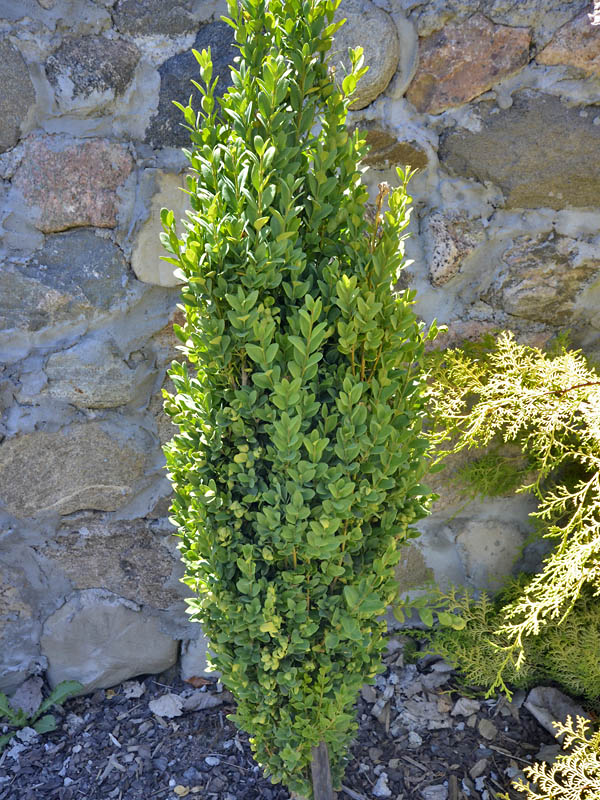
Woody > Buxus > Buxus sempervirens > Buxus sempervirens 'Graham Blandy'
Buxus sempervirens
'Graham Blandy'
Graham Blandy Boxwood
Origin: Named in honour of Graham Blandy who in 1926 left his 283 plus hectare farm to the University of Virginia to establish the Blandy Experimental Farm. This cultivar of boxwoods was selected at the Blandy Experimental Farm in 1949.
Mike's
Opinion


"
‘Graham Blandy’ boxwood is a beautiful, multiple purpose shrub. It can be used as an accent when planted by itself, grouped together to form a hedge and can even be used as a screen. Like a lot of boxwoods, the leaves are oblong, new growth is a soft green in the spring then changes to a deep rich green in the summer and autumn and continues to stay green through the winter.
Michael Pascoe, NDP., ODH., CLT., MSc. (Plant Conservation)
"
| Family |
| Buxaceae |
| Genus |
| Buxus |
| Species |
| sempervirens |
| Cultivar |
| 'Graham Blandy' |
| Category |
| Woody |
| Type |
| Tree (evergreen) |
| Pronunciation |
| USDA Hardiness Zone |
| 5 - 9 |
| Canadian Hardiness Zone |
| 4a |
| RHS Hardiness Zone |
| H6 |
| Temperature (°C) |
| -20 to -15 |
| Temperature (°F) |
| (-15) - 30 |
| Height |
| 1.5-3 m |
| Spread |
| 60-90 cm |
Photographs
Description and Growing Information
Flowering Period
| General Description |
| A very fastigiate shrub that grows at a slow rate, maintaining its beautiful green foliage year round. |
| Landscape |
| ‘Graham Blandy’ is commonly used as hedge, but can also be used as a screen when plants are grouped together. With its green foliage all year round it is a great accent shrub throughout the winter seasons. |
| Cultivation |
| Moist, alkaline soils with full sun to partial shade. |
| Shape |
| A narrow, upright column that is dense, with deep green leaves and reaches about 1.5 m in height. |
| Growth |
| Slow |
| ID Characteristic |
| Pests |
| Caterpillars, leaf miners and boxwood mites. As of late Boxwood blight has become a major problem both in Europe and most of North America. The fungus Cylindrocladium buxicola causes leaf spots, defoliation and even extensive die-back. The disease can be spread by water splash, tools and footwear. |
| Habitat |
| Horticultural origin. |
| Bark/Stem Description |
| Fine with soft brown to light grey bark. |
| Flower/Leaf Bud Description |
| Very small in size, single or paired and oval in shape. |
| Leaf Description |
| Small simple oblong leaves 40 mm in length that are light green in the spring turning a rich green in the summer and persist all year round. |
| Flower Description |
| Small white flowers which are quite fragrant. |
| Fruit Description |
| Small, green, hard capsules that are normally found in groups of three. |
| Colour Description |
| Fresh green leaves, soft in the spring and dark in summer. Brown to light grey bark and small white flowers. |
| Texture Description |
| Fine texture. |
| Notable Specimens |
| Whistling Gardens, Wilsonville, Ontario, Canada. |
| Propagation |
| Propagate in mid-summer by taking semi-ripe cuttings from the current season's growth. Collect in the early morning using a sharp knife to cut pieces 10-15 cm in length. Remove all leaves from the lower third and pinch out any soft terminal growth. Dip into a number 2 rooting hormone, insert into trays or pots of cutting compost and water well. Place in a propagator with bottom heat set at 15°C with or without mist; rooting should occur in 4-6 weeks. |
References
Zion, Robert L. "Trees for Architecture and Landscape." Second Edition.
London, England WCIV 7AA, International Thomson Publishing Europe, 1995.
Toogood, Alan. American Horticultural Society; "Plant Propagation."
375 Hudson Street, New York, NY 10014, DK Publishing, INC, 1999.


